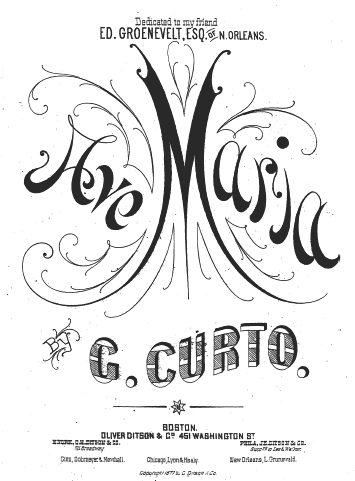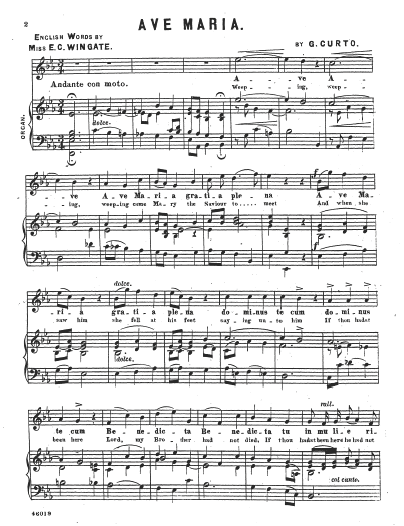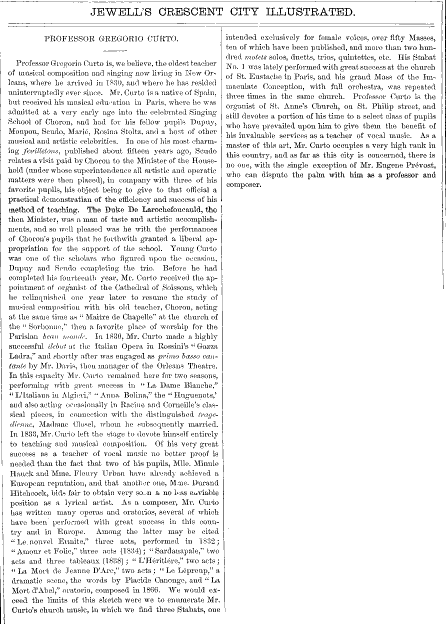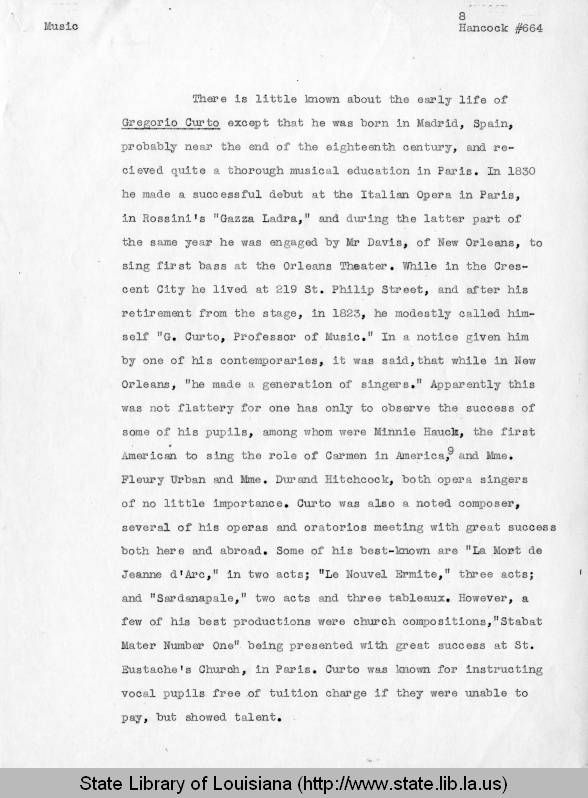Ave Maria
Composer: Gregorio Curto (c1810-1887), 1877

 |
 |
 |
X |
X |
|
Gregorio |
|
Curto |
|
|
|
|
1877 |
|
|
Ave Maria |
solo voice |
organ |
|
X |
X |
X |
 |
X |
|
Gregorio |
|
Curto |
|
|
|
|
|
|
|
Ave Maria |
solo voice |
organ |

| Recording: not available |
| Lyrics: |
A-ve, A-ve A-ve Ma-ri-a
gra-ti-a ple-na
A-ve Ma-ri-a, gra-ti-a ple-na
do-mi-nus te-cum, do-mi-mus te-cum.
Be-ne-dic-ta, Be-ne-dic-ta tu in mu-li-e-ri-bus
et Be-ne-dic-tus,
et Be-ne-dic-tus Fruc-tus ven-tris tu-i, Je-susA-ve Ma-ri-a
gra-ti-a-ple-na,
do-mi-nus te-cum
Be-ne-dic-ta tu in mu-li-e-ri-bus
et Be-ne-dic-tus fruc-tus ven-tris tu-i, Je-sus. |
A-ve Ma-ri-a, gra-ti-a ple-na
Do-mi-nus te-cum
Be-ne-dic-ta Sanc-ta Sanc-ta-Ma-ri-a,
Ma-ter De-i, o-ra pro no-bisSanc-ta Ma-ri a
O-ra pro no-bis pec-ca-to ri-bus,
nunc et in ho-ra, in ho-ra mor-tis nos-trae, mor-tis nos-trae.
Ma-ter De-i, o-ra pro-no-bis pec-ca-to-ri-bus
nunc et in ho-ra mor-tis, in ho-ra mor-tis nos-trae,
A-men, A-men. |
 Score:
Score: |
|
 |
 |
|
|
| Internet reference:
JEWELL'S CRESCENT CITY ILLUSTRATED (1878). |

PROFESSOR GREGORIO CURTO.
Professor Gregorio Curto is, we believe, the oldest teacher of musical
composition and singing now living in New Orleans, where he arrived in 1830,
and where he has resided uninterruptedly ever since.
Mr. Curto is a native of Spain, but received his musical education in Paris,
where he was admitted at a very early age into the celebrated Singing School
of Choron, and had for his fellow pupils Dupuy, Monpou, Scudo, Marie, Rosina
Stoltz, and a host of other musical and artistic celebrities. In one of his
most charming feuilletons, published about fifteen years ago, Scudo relates
a visit paid by Choron to the Minister of the Household (under whose
superintendence all artistic and operatic matters were then placed), in
company with three of his favorite pupils, his object being to give to that
official a practical domonstratian of the efficiency and success of his
method of teaching. The Duke Be Larochefoucauld, the then Minister, was a
man of taste and artistic accomplishments, and so well pleased was he with
the performances of Choroids pupils that he forthwith granted a liberal
appropriation for the support of the school. Young Curto was one of the
scholars who figured upon the occasion, Dupuy and Scudo completing the trio.
Before he had completed his fourteenth year, Mr. Curto received the
appointment of organist of the Cathedral of Soissons, which he relinquished
one year later to resume the study of musical composition with his old
teacher, Choron, acting at the same time as " Maitre de Chapelle" at the
church, of the " Sorbonne," then a favorite place of worship for the
Parisian beau monde.
In 1830, Mr. Curto made a highly successful debut at the Italian Opera in
Rossini's " Gazza Ladra," and shortly after was engaged as primo basso
cantante by Mr. Davis, then manager of the Orleans Theatre. In this capacity
Mr. Curto remained here for two seasons, performing with great success in "
La Dame Blanche," " L'ltaliana in Algieri," " Anna Bolina," the u Huguenots/
and also acting occasionally in Racine and Corneille's classical pieces, in
connection with the distinguished tragedienne, Madame Close!, whom he
subsequently married.
In 1883, Mr. Curto left the stage to devote himself entirely to teaching and
musical composition. Of his very great success as a teacher of vocal music
no better proof is needed than the fact that two of his pupils, Mile. Minnie
Hauck and Mine. Fleury Urban have already achieved a European reputation,
and that another one, Mme. Durand Hitchcock, bids fair to obtain very soon a
no less enviable position as a lyrical artist.
As a composer, Mr. Curto has written many operas and oratorios, several of
which have been performed with great success in this country and in Europe.
Among the latter may be cited "Le.nouvel Ermite," three acts, performed in
1832; " Amour et Folie," three acts (1834); " Sardanapale," two acts and
three tableaux (1838); " L'Heritiere," two acts; " La Mort de Jeanne D'Arc,"
two acts ; " Le Lepreup," a dramatic scene, the words by Placide Canonge,
and " La Mort d'Abel," oratorio, composed in 1866.
We would exceed the limits of this sketch were we to enumerate Mr. Curto's
church music, in which we find three Stabats, one intended exclusively for
female voices, over fifty Masses, ten of which have been published, and more
than two hundred motets solos, duetts, trios, quintettes, etc. His Stabat
No. 1 was lately performed with great success at the church of St. Eustache
in Paris, and his grand Mass of the Immaculate Conception, with full
orchestra, was repeated three times in the same church.
Professor Curto is the organist of St. Anne's Church, on St. Philip street,
and still devotes a portion of his time to a select class of pupils who have
prevailed upon him to give them the benefit of his invaluable services as a
teacher of vocal music. As a master of this art, Mr. Curto occupies a very
high rank in this country, and as far as this city is concerned, there is no
one, with the single exception of Mr. Eugene Prevost, who can dispute the
palm with him as a professor and composer. |
| Internet reference:
|
 |

Page last modified:
November 15, 2011
Return to my homepage:
www.avemariasongs.org

|
![]()